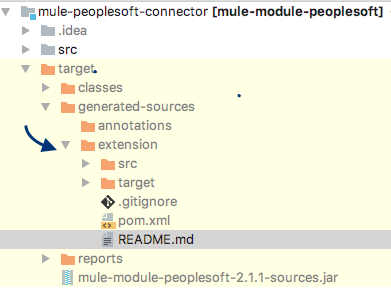<parent>
<groupId>org.mule.tools.devkit</groupId>
<artifactId>mule-devkit-parent</artifactId>
<version>3.9.4</version>
</parent>DevKit Migration Tool
The DevKit Migration Tool (DMT) helps you migrate from a Connector built with DevKit that runs on Mule 3.x to a project that is compatible with Mule 4 SDK.
Anypoint Connector DevKit is not compatible with Mule 4. If you developed your own DevKit project for Mule 3, you’ll need to migrate it to the new SDK in order to use it in a Mule 4 application.
Compatibility Rules
When migrating a connector, be aware of the compatibility rules:
-
Migration is guaranteed only for the latest DevKit versions (3.8.0 or higher).
-
Connectors that do not respect the latest verifications or that use deprecated components or annotations won’t be taken into account if any problem occurs while migrating.
-
Some concepts don’t exist in Mule 4. This tool won’t migrate pieces which are affected by unsupported components, and might migrate code that fails to follow the best practices that MuleSoft enforces in the SDK.
-
Some features are very different in Mule 4, such as the DataSense model.
Features that won’t be migrated include:
-
Inbound/outbound message properties
-
The ability to directly manipulate the Mule Message/Event
-
Ability to change or query variables
After the migration, you might need to change the code or behavior in your module for the features that are no longer supported.
Migrating a DevKit Connector
DMT migrates your project, performing the heavy lifting for you. However, you must review and adjust the migration results.
Manual work is required to make your project work properly.
The DMT performs these tasks for you:
-
Generates new source code compatible with the new SDK extension model, which wraps the current connector code as it would any other Java library
-
Delegates responsibility for the code to the already-tested connector code
-
Marks errors with inline comments in the generated code and points you to documentation that explains next steps to resolve the errors
Running DMT
To run DMT, adjust your connector pom.xml and build the connector from the command line.
-
Open the connector’s
pom.xmlfile and find theparentartifact: -
Change the values of
groupId,artifactIdandversion:<parent> <groupId>org.mule.tools.dmt</groupId> <artifactId>mule-dmt</artifactId> <version>1.0.0</version> </parent> -
Now that the
parenthas been changed, build your connector from the IDE or the command line:mvn clean package
Test classes aren’t run, migrated, or copied because they won’t compile using the SDK. If you want to keep test classes in the migrated project, build the connector with the property
-DexcludeTests=false.mvn clean package -DexcludeTests=false
Once the process finishes, a Build Success message is displayed.
The generated extension project is placed under the {rootdir}/target/generated-sources/extension folder.

Supported Components
The following elements of a DevKit connector are ported to the new extension representation.
-
Processors
All the processors are migrated to Operations, all within the same class. Parameters of the Processor should be reflected in the Operation parameters and also elements as Config or injected fields present in the old Connector that should be set up are passed in as parameters.
See SDK Operations Documentation Reference to learn more about extension operations.
-
Sources
Both polling and triggered sources are migrated to a new Source class.
By default, code for Sources compiles and runs, but comments are added to the generated sources classes so you can improve the usability of your recently migrated connector.
See: SDK Sources Documentation Reference to learn more about extension sources.
-
Connection Strategies
Both @Configuration and @ConnectionManagement strategies are migrated.
See: Connections in the SDK to learn more about connections.
-
Configuration
@Configuration strategies are migrated to a CachedConnectionProvider, which provides a single connection instance for all operations until that connection is stopped.
-
Connection Management
@ConnectionManagement strategies are migrated to a PoolingConnectionProvider, so the generated connections are pooled. A cache of connections is maintained so that they can be reused when future requests require one.
If the @ConnectionManagement connect method is marked as "Single Instance," it is migrated to a CachedConnectionProvider, as @Configuration strategies are migrated.
These elements are also supported:
-
Metadata (MetaData Objects are not migrated, manual migration to the MetadataTypes is required)



